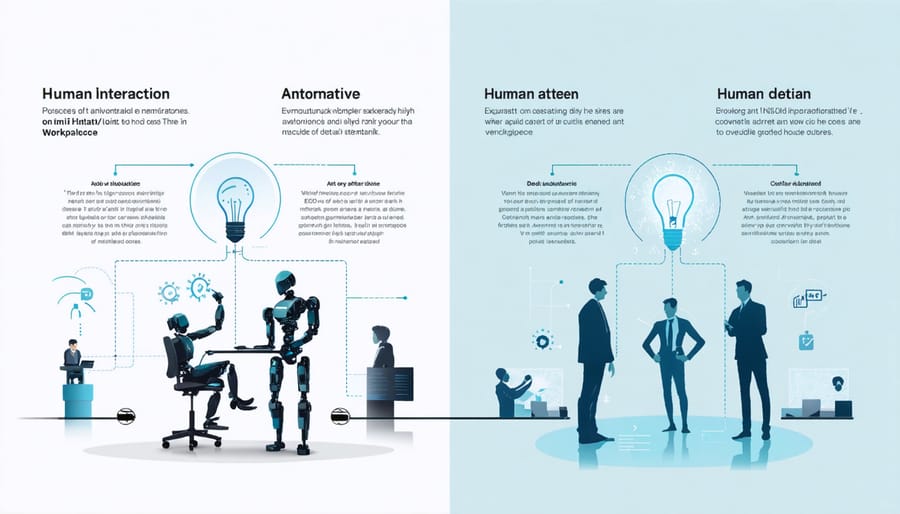How Digital Leaders Drive Real Business Transformation (Even When Teams Resist)

Transform organizational mindsets before technology by establishing clear digital vision statements, measurable success metrics, and behavioral expectations across all leadership levels. Lead successful digital transformation initiatives through data-driven decision making, implementing AI-powered analytics dashboards and real-time performance monitoring systems that align with strategic objectives.
Cultivate digital fluency among executive teams through immersive training programs, hands-on technology workshops, and regular exposure to emerging digital tools and platforms. Build cross-functional innovation teams that combine technical expertise with business acumen, ensuring digital initiatives deliver measurable ROI while maintaining operational excellence.
Master change management in the digital age by developing clear communication channels, establishing feedback loops, and creating collaborative spaces where teams can experiment safely with new technologies. Focus on building a culture of continuous learning and adaptation, where digital innovation becomes a natural part of organizational DNA rather than a separate initiative.
The Modern Digital Leader’s Toolkit
Adaptive Decision Making
Successful digital leaders understand that effective decision-making in today’s fast-paced business environment requires a delicate balance between data-driven insights and adaptable strategies. They recognize that while analytics provide crucial insights, market conditions can shift rapidly, demanding quick adjustments to predetermined plans.
These leaders implement flexible decision-making frameworks that combine real-time data analysis with agile response mechanisms. They establish clear metrics for success while maintaining enough operational flexibility to pivot when market conditions change. This approach involves:
• Regular review of key performance indicators
• Continuous feedback loops from team members and customers
• Quick implementation of necessary adjustments
• Balanced risk assessment protocols
The most effective digital leaders also cultivate a culture of informed experimentation, where teams feel empowered to test new approaches while maintaining accountability through measurable outcomes. They understand that successful digital transformation requires both systematic analysis and the ability to make swift, calculated decisions when opportunities or challenges arise.
This balanced approach ensures organizations can capitalize on data-backed opportunities while remaining responsive to unexpected market shifts, technological advances, or changing customer needs.
Digital-First Strategic Vision
A successful digital transformation begins with a clear, forward-thinking vision that aligns technology initiatives with business objectives. Leaders must craft a comprehensive roadmap that not only outlines the technical implementation but also addresses organizational change and cultural evolution.
Start by assessing your current digital maturity and identifying gaps between present capabilities and future needs. Your vision should articulate how digital technologies will create value for customers, employees, and stakeholders. Focus on specific, measurable outcomes rather than vague technological aspirations.
Communication is crucial – your vision must be easily understood at all levels of the organization. Break down the transformation journey into digestible phases, each with clear milestones and success metrics. Consider creating visual representations of your roadmap to help team members understand their role in the bigger picture.
Remember that your digital vision should be flexible enough to adapt to emerging technologies and changing market conditions. Regular review and adjustment of your strategic roadmap ensures it remains relevant and achievable. Encourage feedback from all stakeholders and use their insights to refine your approach.
Your vision should emphasize how digital transformation will enhance customer experience, streamline operations, and drive innovation, while maintaining focus on sustainable, long-term business growth.

Building a Digital-Ready Workforce
Skills Gap Assessment
A successful digital transformation starts with a thorough assessment of your organization’s current digital capabilities and the identification of skill gaps that need to be addressed. Begin by conducting a comprehensive audit of your team’s existing digital competencies, including technical skills, digital literacy, and adaptability to new technologies.
Create a skills matrix that maps essential digital competencies against your strategic objectives. This should include both hard skills like data analytics, cloud computing, and digital marketing, as well as soft skills such as digital collaboration and virtual team management. Compare your current workforce capabilities against these required competencies to identify gaps.
Once gaps are identified, prioritize them based on their impact on business objectives and urgency. Consider both immediate needs and future requirements as technology continues to evolve. Develop a structured learning and development plan that includes various training approaches:
– Internal mentoring programs
– Online learning platforms
– Professional certification courses
– Hands-on project experience
– Cross-functional team collaboration
Regular assessment intervals help track progress and adjust training strategies as needed. Remember that skills development is an ongoing process, not a one-time effort. Consider implementing digital proficiency metrics into performance evaluations to ensure continuous improvement and accountability.
Partner with HR to create clear career development paths that incorporate digital skill advancement. This approach not only addresses current gaps but also helps retain talent by showing commitment to employee growth in the digital age.

Cultural Transformation
Creating a culture that embraces digital transformation is crucial for long-term success in today’s business environment. This cultural shift begins with leadership consistently demonstrating commitment to digital innovation and encouraging employees to adapt to new technologies and processes.
Start by establishing clear communication channels that promote transparency and open dialogue about digital initiatives. Regular town halls, team meetings, and digital collaboration platforms can help employees feel included in the transformation journey and understand its importance to the organization’s future.
Implement a continuous learning program that provides employees with opportunities to develop digital skills. This can include online courses, workshops, mentoring programs, and hands-on experience with new technologies. Recognize and reward employees who actively participate in digital initiatives and share their knowledge with colleagues.
Foster an environment where experimentation and calculated risk-taking are encouraged. Create safe spaces for teams to test new digital solutions and learn from failures without fear of negative consequences. This approach helps build confidence and resilience while driving innovation.
Break down departmental silos by forming cross-functional teams that collaborate on digital projects. This not only spreads digital knowledge throughout the organization but also creates champions who can influence others and accelerate adoption.
Remember that cultural transformation takes time and patience. Regular assessment of employee engagement and feedback helps identify areas where additional support or adjustments are needed. Celebrate small wins and share success stories to maintain momentum and demonstrate the positive impact of digital transformation on the organization.
Change Management in the Digital Age
Overcoming Digital Resistance
Digital resistance is a common challenge that every transformational leader must address head-on. Understanding and proactively managing this resistance is crucial for successful digital transformation initiatives. Start by identifying the root causes of resistance, which typically include fear of job displacement, comfort with existing processes, and lack of digital literacy among team members.
To overcome these barriers, implement a clear communication strategy that emphasizes the benefits of digital transformation for both the organization and individual employees. Create a safe environment where team members can voice their concerns and receive support during the transition. Establish a comprehensive training program that helps employees develop necessary digital skills while building their confidence in using new technologies.
Consider adopting a phased approach to implementation, starting with small, manageable changes that demonstrate quick wins. This builds trust and momentum while reducing anxiety about large-scale changes. Identify and empower digital champions within your organization who can help drive adoption and provide peer-to-peer support.
Address concerns about job security by highlighting how digital transformation creates new opportunities for skill development and career growth. Set realistic expectations about the transformation timeline and be transparent about potential challenges. Remember that resistance often stems from legitimate concerns, so maintain an open dialogue and adjust your approach based on feedback.
Celebrate early successes and share positive outcomes to maintain motivation and demonstrate the tangible benefits of digital initiatives. This helps create a culture of continuous improvement and innovation, making future digital changes easier to implement.
Measuring Transformation Success
Measuring the success of digital transformation initiatives requires a balanced approach focusing on both quantitative and qualitative indicators. Organizations should establish clear Key Performance Indicators (KPIs) that align with their transformation goals and regularly monitor progress through various digital tools and solutions.
Essential metrics to track include:
Employee Adoption Rate: Monitor how quickly and effectively team members embrace new digital systems and processes. This can be measured through usage statistics, training completion rates, and employee feedback surveys.
Customer Experience Metrics: Track customer satisfaction scores, Net Promoter Score (NPS), digital channel engagement rates, and response times to assess the impact of transformation on customer relationships.
Operational Efficiency: Measure improvements in process completion times, error rates, and cost savings achieved through automation and digital optimization.
Revenue Impact: Monitor digital revenue streams, conversion rates, and the ROI of digital investments.
Innovation Metrics: Track the number of new digital initiatives launched, time-to-market for new features, and the success rate of digital experiments.
Creating a transformation scorecard that combines these metrics provides a comprehensive view of progress while helping identify areas requiring additional attention or resources. Regular review cycles ensure the transformation stays on track and allows for timely adjustments to strategy when needed.
Technology Integration and Process Automation
Balancing Automation and Human Touch
In the digital age, successful transformation requires a delicate balance between automation and human interaction. While automation drives efficiency and scalability, the human element remains crucial for building trust and maintaining meaningful relationships with both employees and customers.
Start by identifying processes that can be automated without compromising personal connections. Repetitive tasks like data entry, report generation, and basic customer inquiries are prime candidates for automation. However, reserve human interaction for complex problem-solving, strategic discussions, and emotional support scenarios.
Implement a hybrid approach where technology augments rather than replaces human capabilities. For example, use AI-powered analytics to identify customer patterns, but let your team handle the personal outreach. Regular check-ins, face-to-face meetings (virtual or in-person), and personalized communication help maintain the human touch while leveraging digital tools.
Create clear guidelines for when to use automated solutions versus human intervention. Train your team to recognize these situations and empower them to make appropriate decisions. Remember, technology should enhance human capabilities, not diminish them. The goal is to use automation to free up time for more meaningful interactions and strategic thinking.

Digital Tools Selection
Selecting the right digital tools is crucial for successful transformation initiatives. Start by conducting a thorough needs assessment of your organization, identifying key pain points and operational bottlenecks that technology could address. Create a prioritized list of requirements, focusing on tools that align with your strategic objectives and offer measurable ROI.
Consider these essential criteria when evaluating digital tools:
– Scalability and integration capabilities with existing systems
– User-friendliness and learning curve for staff
– Security features and compliance requirements
– Total cost of ownership, including maintenance and training
– Vendor reputation and support quality
– Mobile accessibility and remote work capabilities
Implement a pilot program before full deployment to test effectiveness and gather user feedback. This approach minimizes risks and allows for adjustments before significant investment. Remember to involve key stakeholders in the selection process, ensuring buy-in from those who will use the tools daily.
Create a clear implementation timeline and establish metrics for success. Regular evaluation of tool performance helps maintain alignment with organizational goals and identifies areas for optimization or replacement when necessary.
Digital transformational leadership requires a delicate balance of technical expertise, people skills, and strategic vision. As we’ve explored throughout this article, successful digital leaders must embrace change while maintaining organizational stability and employee engagement.
To implement effective digital transformation in your organization, start by assessing your current digital maturity and identifying key areas for improvement. Develop a clear roadmap that prioritizes both quick wins and long-term strategic goals. Remember that technology is merely an enabler – the real transformation happens through people and processes.
Focus on building a culture of continuous learning and innovation. Encourage experimentation while maintaining clear guidelines for risk management. Invest in upskilling your team and create opportunities for cross-functional collaboration.
Key action items for immediate implementation include:
– Conduct regular digital literacy assessments across your organization
– Establish clear communication channels for change management
– Create metrics to measure transformation progress
– Develop a feedback loop system for continuous improvement
– Build strategic partnerships with technology providers
– Foster an inclusive environment that welcomes diverse perspectives
Remember that digital transformation is not a destination but a journey. Stay flexible and ready to adapt your leadership style as new technologies emerge and market conditions change. Most importantly, maintain a strong focus on customer needs and employee well-being throughout the transformation process.
Success in digital transformation comes from consistent, purposeful leadership that balances innovation with stability, and technology with human connection.
Leave a Reply